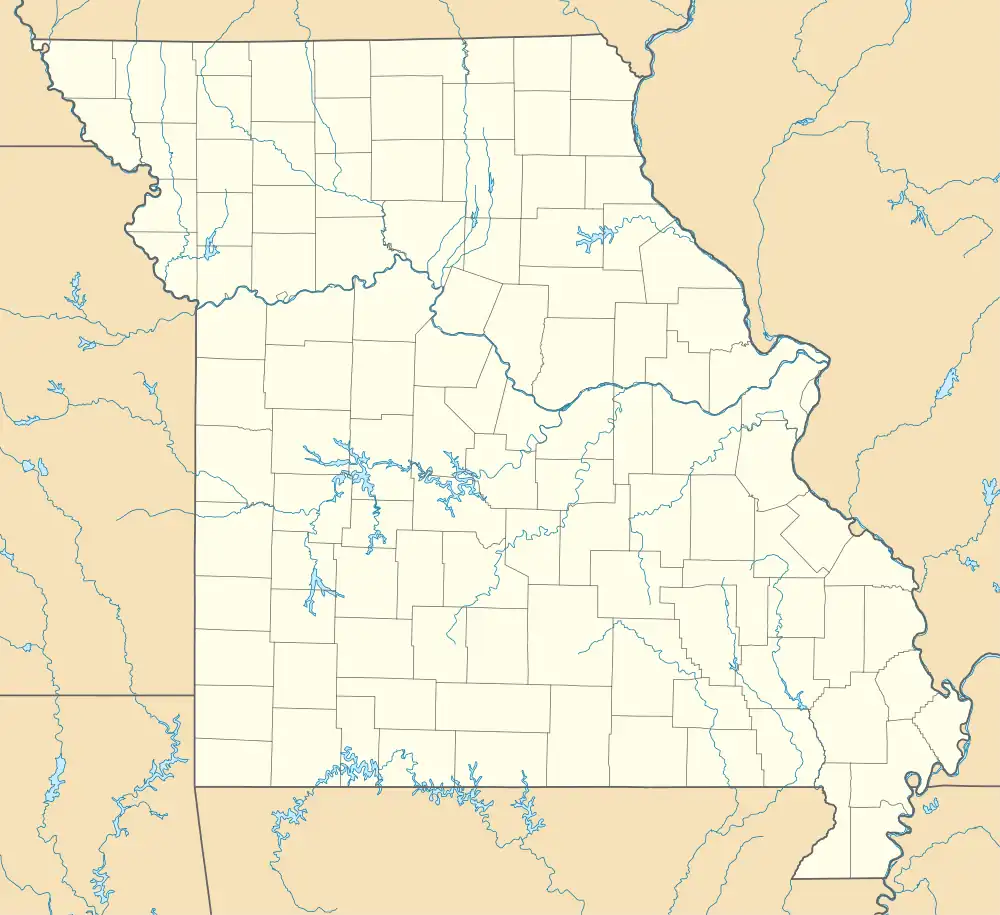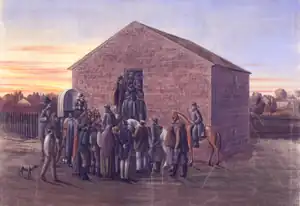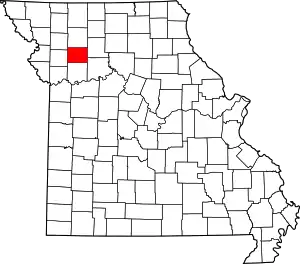Far West | |
|---|---|
Town | |
 Community of Christ chapel in Far West | |
 Far West  Far West | |
| Coordinates: 39°40′16″N 94°07′54″W / 39.6711°N 94.1317°W | |
| Elevation | 292 m (958 ft) |
| GNIS feature ID | 0738427[1] |
Far West | |
| Location | 5.5 miles (8.9 km) west of Kingston via County Roads D and H, near Kingston, Missouri |
| Area | 640 acres (260 ha) |
| Built | 1836 |
| NRHP reference No. | 70000324[2] |
| Added to NRHP | September 22, 1970 |
| Far West Temple | |
|---|---|
| Efforts halted in 1830s | |
 Monument at the temple site in Far West. | |
| Site | 640 acres (260 ha) |
| • News & images | |
| Additional information | |
| Announced | April 16, 1838, by Joseph Smith |
| Groundbreaking | July 4, 1838, by Quorum of the Twelve |
| Location | Far West, Caldwell County, Missouri, United States |
| Notes | Site Dedicated. Cornerstones laid and dedicated July 4, 1838. Efforts discontinued in 1800s. The cornerstones remain, covered in glass, as part of a memorial park at the site. |
| () | |
Far West was a settlement of the Latter Day Saint movement in Caldwell County, Missouri, United States, during the late 1830s. It is recognized as a historic site by the U.S. National Register of Historic Places, added to the register in 1970. It is owned and maintained by the Church of Jesus Christ of Latter-day Saints.
Foundation and early history
The town was founded by Missouri leaders of the church, W. W. Phelps and John Whitmer in August 1836 shortly before the county's creation. The town was platted originally as a 1-mile (1.6 km) square area, centered on a public square which was to house a temple. The design of the town resembled the plan of Joseph Smith Jr. (the first modern-day prophet of the Latter Day Saint Movement) for the City of Zion, which had been planned to be built in the town of Independence, Missouri. As the town of Far West grew, the plat was extended to 4 square miles (10 km2).[3]
Early Latter-day Saints began to settle in northwestern Missouri soon after the church was organized in 1830. According to a revelation given by Joseph Smith Jr., Independence would be the "centerplace" of the City of Zion when Jesus returned. However, disputes between early members of the church and Missourian settlers in Independence led to the expulsion of the early members of the church from Jackson County in 1833. Most temporarily settled in Clay County, Missouri. Towards the end of 1836, Caldwell County was created specifically for a settlement of members of the church to compensate property losses in Jackson County. Shortly after the creation of Caldwell County, Far West was made the county seat.[4]
Far West became the headquarters of the church in early 1838 when Joseph Smith and Sidney Rigdon relocated to the town from the previous church headquarters in Kirtland, Ohio. Joseph Smith taught that the Garden of Eden had been in Jackson County and when Adam and Eve were expelled from the Garden, they moved to the area now comprising Caldwell and Daviess Counties, Missouri. While headquartered in Far West, the official name of the church was changed to The Church of Jesus Christ of Latter Day Saints, after previously being known as the Church of Christ from 1830 to 1834 and as the Church of the Latter Day Saints, and variations of that name, since 1834.[5]
Missourian conflict of 1838
New problems erupted when members of the church began to settle in the counties surrounding Caldwell, including De Witt in Carroll County and Adam-ondi-Ahman in Daviess County. Fear that the growing number of Saints would outnumber the local citizens, and misunderstandings regarding the doctrine, purposes, and practices of the church, created a series of escalating conflicts, and the Governor of Missouri eventually called out 2,500 state militiamen to put down what he alleged to be a "Mormon rebellion." He also issued an extermination order to rid the state of the church. Terrified, members of the church poured into Far West for protection and found themselves under siege. Joseph Smith Jr., Sidney Rigdon, and others surrendered at the end of October 1838, hoping to alleviate the persecution on the main church body of members, but were put on trial by the state for treason on trumped up false charges. The main body of the church was then forced illegally to sign over their property in Far West and Caldwell County to pay for the militia muster and then leave the state. The main body later settled in Nauvoo, Illinois.
Aftermath and Far West today
Far West became a ghost town soon after the departure of most of the church population. The county seat was moved to Kingston, Missouri[6] and many of the log houses in Far West were relocated. John Whitmer continued to live in the nearly empty town, where he owned a large farm.
The Church of Jesus Christ of Latter-day Saints purchased the temple site and some of the surrounding area in 1909.[7] Since then, Far West has been maintained as a historic site. It is located 7 miles (11 km) south of U.S. Route 36 on Missouri Route D. The site includes the cornerstones of the planned temple, each encased in glass, and a monument to the early settlers that was dedicated in 1968. The church also honors the Far West legacy in the name of a ward located in Cameron and, since 2015, a stake centered in Gallatin.
Community of Christ, formerly known as the Reorganized Church of Jesus Christ of Latter Day Saints, has a congregation that meets in Far West, across the street from the historic site.[8]
In 2004 construction began on a historic village adjacent to the temple site. It is operated by the Far West Historical Society to accommodate and increase tourism. The Country Store has been in operation since 2006.
In May 2012, The Church of Jesus Christ of Latter-day Saints confirmed that it purchased 6,000 acres (2,400 ha) of Missouri farmland and three historical sites from Community of Christ, including land around Far West.[9]
References
- 1 2 U.S. Geological Survey Geographic Names Information System: Far West, Missouri
- ↑ "National Register Information System – (#70000324)". National Register of Historic Places. National Park Service. July 9, 2010.
- ↑ H. Roger Grant (April 1970). "National Register of Historic Places Inventory Nomination Form: Far West" (PDF). Missouri Department of Natural Resources. Retrieved September 1, 2016.
- ↑ "Caldwell County Place Names, 1928–1945 (archived)". The State Historical Society of Missouri. Archived from the original on June 24, 2016. Retrieved September 7, 2016.
{{cite web}}: CS1 maint: bot: original URL status unknown (link) - ↑ Anderson, Richard Lloyd (January 1979). "I Have a Question: What changes have been made in the name of the Church?". Ensign. The Church of Jesus Christ of Latter-day Saints. Retrieved November 23, 2020.
- ↑ "Disappearing Missouri Names". The Kansas City Star. March 19, 1911. p. 15. Retrieved August 15, 2014 – via Newspapers.com.

- ↑ Lund, Jennifer L. (2013). "Joseph F. Smith and the Origins of the Church Historic Sites Program". In Manscill, Craig K.; Reeves, Brian D.; Dorius, Guy L.; Haws, J. B. (eds.). Joseph F. Smith: Reflections on the Man and His Times. Salt Lake City: Deseret Book. pp. 342–358. Retrieved November 23, 2020.
- ↑ "Congregation". Community of Christ. Archived from the original on December 16, 2021. Retrieved November 17, 2020.
- ↑ Askar, Jamshid Ghazi (May 5, 2012). "LDS Church buys farmland, Haun's Mill, Far West, Kirtland property from Community of Christ". Deseret News. Salt Lake City. Retrieved September 14, 2012.
- Alexander L. Baugh, A Call to Arms: The 1838 Mormon Defense of Northern Missouri, BYU Studies, 2000.
- John Hamer, Northeast of Eden: A Historical Atlas of Missouri's Mormon County, Far West Cultural Center, 2004.
- Stephen C. LeSueur, The 1838 Mormon War in Missouri, University of Missouri Press, 1990.
External links
![]() Media related to Far West, Missouri at Wikimedia Commons
Media related to Far West, Missouri at Wikimedia Commons
- https://web.archive.org/web/20070627162626/http://www.farwesthistorical.org/
- Plan of Far West
- Far West Temple Site at ChurchofJesusChristTemples.org



